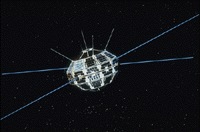


- This family of antennas is what people usually mean when they use the word "antenna"
- This family includes the radio antenna on a car, or the antennas that are on older television sets
- Simple antennas are just long thin pieces of metal that are can be in different shapes (eg. straight, looped, coiled)
- The advantage of simple antennas is, of course, that they are simple; but, unfortunately, they have to be very long in order to be large enough to pick up signals
- Long antennas are a problem in space because a satellite has to be as small as possible to make launching easier and cheaper
- A satellites with a long antenna can store it within itself, and deploy it once in outer space
- For example, STEM (Storable Tubular Extendible Member) antennas unroll once the satellite is in orbit, and remain rigid when deployed
- Transmitting using simple antennas is very inefficient because, unlike a dish, the signal is emitted in a spherical fashion; this means that at least half of the radio waves are sent backwards into empty space (a dish allows the wave to be sent in one direction)
- Simple antennas are very inexpensive
![]()
![]()
